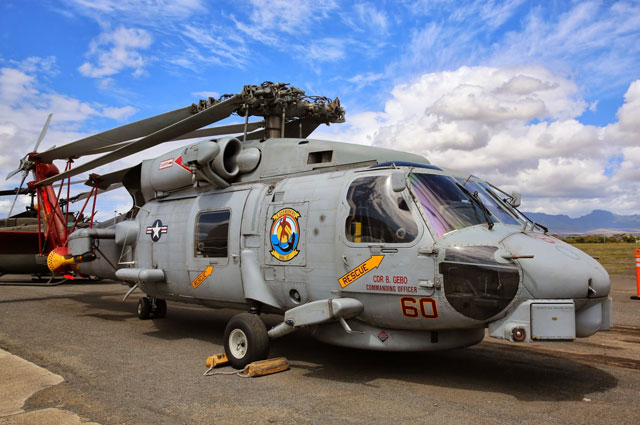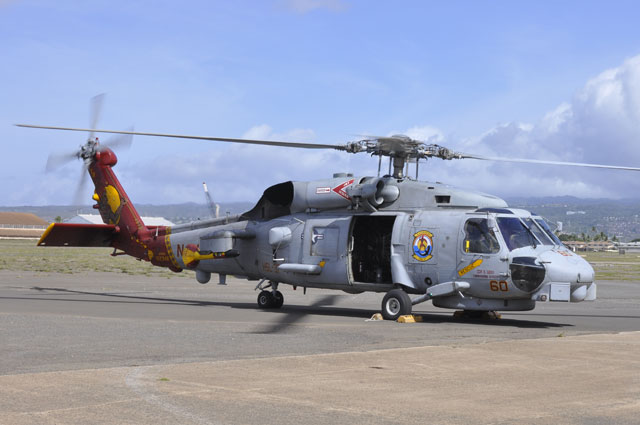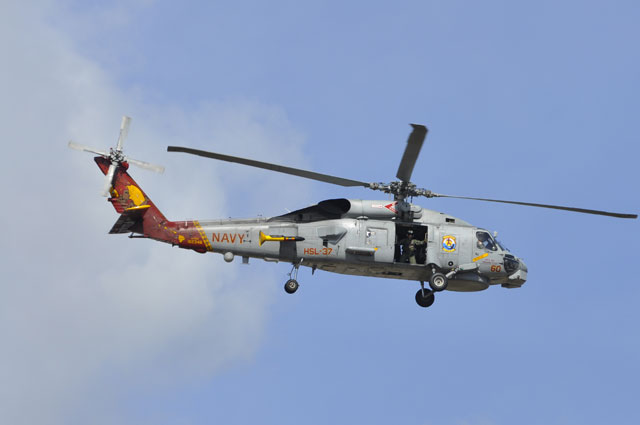
Sikorsky SH-60B Seahawk (Helicopter)
Snapshot
- Nickname:
- Seahawk, LAMPS
- Number Built:
- 181+
- Make:
- Sikorsky Aircraft
- Mission:
- Multimission maritime helicopter
- Location:
- The Raytheon Pavilion & Outdoor Exhibits
Background
What kind of aircraft do you use to sink submarines and carry heavy loads and/or lots of people into and out of danger in all kinds of weather? The answer is a big, armored helicopter with two powerful engines.
The Army “Blackhawk” (UH-60) and Navy SH-60 “Seahawk” helicopters grew out of experiences with the Vietnam era UH-1 Huey. The Huey had done an excellent job, but its casualty rates were high. Bullets easily damaged critical systems, and crash landings were likely to kill everyone in the aircraft. The Huey, with one engine, had limited ability to carry passengers, cargo, or slung loads. This was especially true in hot, high areas, such as the Vietnam highlands.
The Blackhawk has two engines and can carry twice as much as the Huey. It is ballistic resistant, has folding wheels to absorb impact in a crash, and the pilots’ seats do not collapse in a hard landing. Also, it had to fit into a C-130 cargo plane, so it is long rather than tall. Navy Seahawks kept the same silhouette. The most significant airframe modification is a hinged tail to reduce its footprint aboard ships.
The Seahawk replaced SH-3 helicopters for the U.S. Navy, taking over many missions. These missions included, anti-submarine warfare (ASW), mine clearing, anti-ship warfare, naval special warfare insertion of Seal teams, and search and rescue (SAR).
In its role against submarines, the Seahawk carries one torpedo on each side. For clearing mines, it has a 30mm gun. To sink ships, it has Hellfire missiles. Like all naval versions, it has a personnel winch for rescues.
An ASW helicopter has to find enemy submarines lurking near the fleet. One way to do this is to deploy a long wire behind the helicopter. This magnetic anomaly detector, or MAD, can detect the presence of submarines at considerable depth. Our SH-60B has a MAD boom on the right rear of the aircraft.
Our SH-60B also has sonobuoys that float on top of the water and listen for submarines. There is no left-side door but a large window for the operator and 25 sonobuoy tubes. The operator can drop sonobuoys over a wide area to provide a ring of protection around the fleet. It also has modular sensors in its nose.
Specs
- Contractor
- Sikorsky Aircraft Corp
- Deployment Date
- First flight on 12 December 1979
- Length
- 64 feet, 8 inches
- Height
- 17 feet, 2 inches
- Weight
- 15,200 lbs
- Max. Speed
- 146 knots
- Service Ceiling
- 12,000 feet
- Range
- 450 Nautical Miles
- Crew
- 3-4









